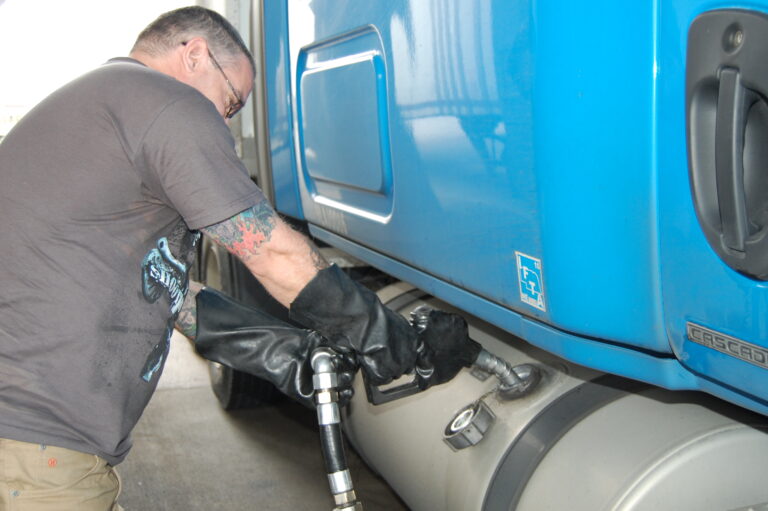For many truck owners, independence means freedom. When you own your own tractor, you can go for the bigger engine. The dual exhaust. The long hood and the fancy chrome bumper.
Truck owners have more freedom in how they choose to drive, too. Company idle standards don’t apply, and in many cases, neither do company speed limits.
One advantage those carriers have with their plain vanilla tractors is that they can maximize fuel efficiency. That’s something that savvy truck owners should be thinking about, too.
There are a lot of reasons why saving fuel is important to a small trucking business, but one you may not have thought about is maximizing fuel surcharge payments. Many drivers look at fuel surcharges as another line on their settlements without realizing that the payment can help them reduce their out-of-pocket per-gallon fuel cost.
Every truck owner, whether operating under their own authority or leased to a carrier as an independent contractor, should be aware of the exact amount of the surcharge for each load. Many carriers accomplish this with a surcharge chart that allows each owner to determine the surcharge payment for each mile. These are usually based on average diesel fuel prices published each Monday by the U.S. Energy Information Administration (eia.gov/petroleum/gasdiesel/). As fuel prices rise and fall, so do fuel surcharges.
It’s important to understand that carriers and shippers calculate fuel surcharges based on an average miles per gallon (mpg) figure. In simple terms, if the fuel surcharge is based on a fleet average of 7 mpg but your truck achieves more than the average, you’re generating additional revenue for your business. That’s because the surcharge amount is calculated based on trip miles – it doesn’t change based on your truck’s fuel consumption.
When fuel prices are high and surcharges are at a peak, it’s possible to cut your out-of-pocket fuel cost in half, or even lower.
Consider a 1,000-mile trip. If your truck achieves 7 mpg, you’ll burn 143 gallons of fuel. If the price of diesel fuel is $2.55, your fuel cost for that trip, at 7 mpg, would be $364.65. If you receive a fuel surcharge of $0.15 per mile, you’ll get $150.00 in fuel surcharge for that trip, reducing your fuel cost to $214.65.
But, if your tractor achieves 9 mpg, you will only consume 111 gallons of fuel for the dispatch. At $2.55 per gallon, your initial cost would be $283.05, a savings of $81.35 from our example above. Subtract the $150 total fuel surcharge from $283.05 and you’ll get $133.05. That’s your final cost for the 111 gallons of fuel you burned on the 1,000-mile trip. That’s a fuel price of less than $1.20 per gallon. The secret to making fuel surcharges pay is getting better fuel mileage than the fleet average used to calculate the surcharge..
If you can increase your fuel efficiency, you’ll burn less fuel AND you’ll pay less for the fuel you burn. The higher the price of fuel, the greater the potential savings to the owner-operator. In fact, when fuel prices are highest, it’s possible to realize a final fuel cost of ZERO.
Taking full advantage of surcharges, however, means adopting many of the practices of the larger carriers. Reducing speed and keeping idle time to a minimum can have a huge impact on fuel mileage. Out of route miles don’t generate revenue and they don’t generate fuel surcharge income, either. The most efficient route is usually the best one. Trucks with sloped hoods, wind fairings, low-profile tires and aftermarket aero treatments like flow-through mud flaps and hub caps will generally get better mileage.
If you lease equipment to a carrier and you’ll be pulling their trailers, ask how the trailers are equipped for aerodynamics. Trailers that aren’t equipped with side skirts, undercarriage “scoops” or collapsible “tails” will require more fuel to pull, at your expense.
When leasing to a carrier or signing an agreement with a customer, be sure you understand how the fuel surcharge is calculated, what it’s based on and when you’ll be paid. Unfortunately, some carriers can be very ambiguous about how the fuel surcharge is paid, so be careful about leasing equipment to a carrier who can’t clearly explain the surcharge.
The fuel surcharge was developed to help carriers and shippers cope with fluctuating fuel prices. By understanding how it works and making it work to your advantage, you can add revenue to your bottom line.
Cliff Abbott is an experienced commercial vehicle driver and owner-operator who still holds a CDL in his home state of Alabama. In nearly 40 years in trucking, he’s been an instructor and trainer and has managed safety and recruiting operations for several carriers. Having never lost his love of the road, Cliff has written a book and hundreds of songs and has been writing for The Trucker for more than a decade.





















